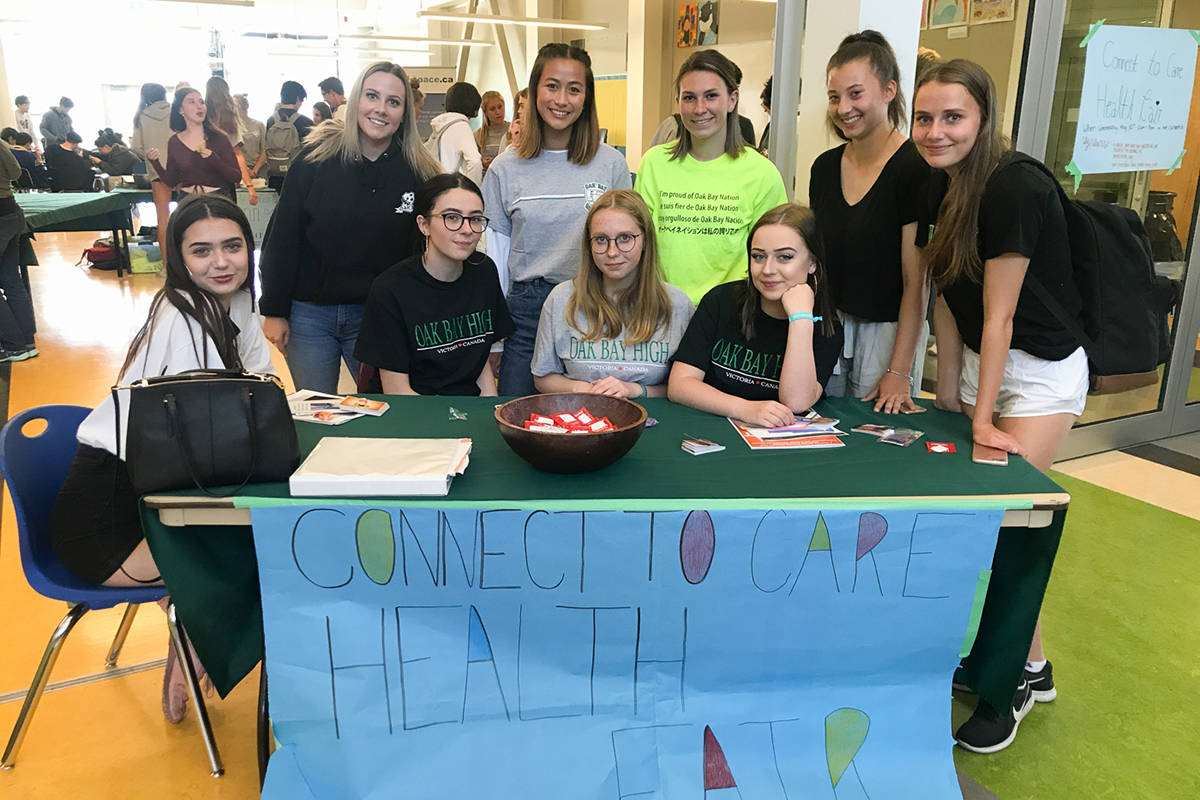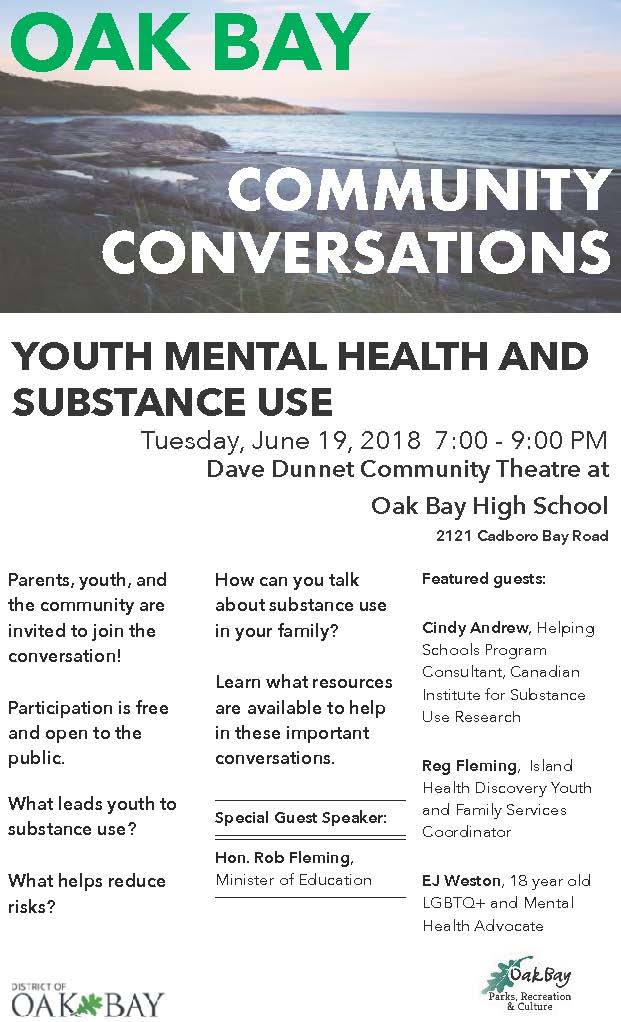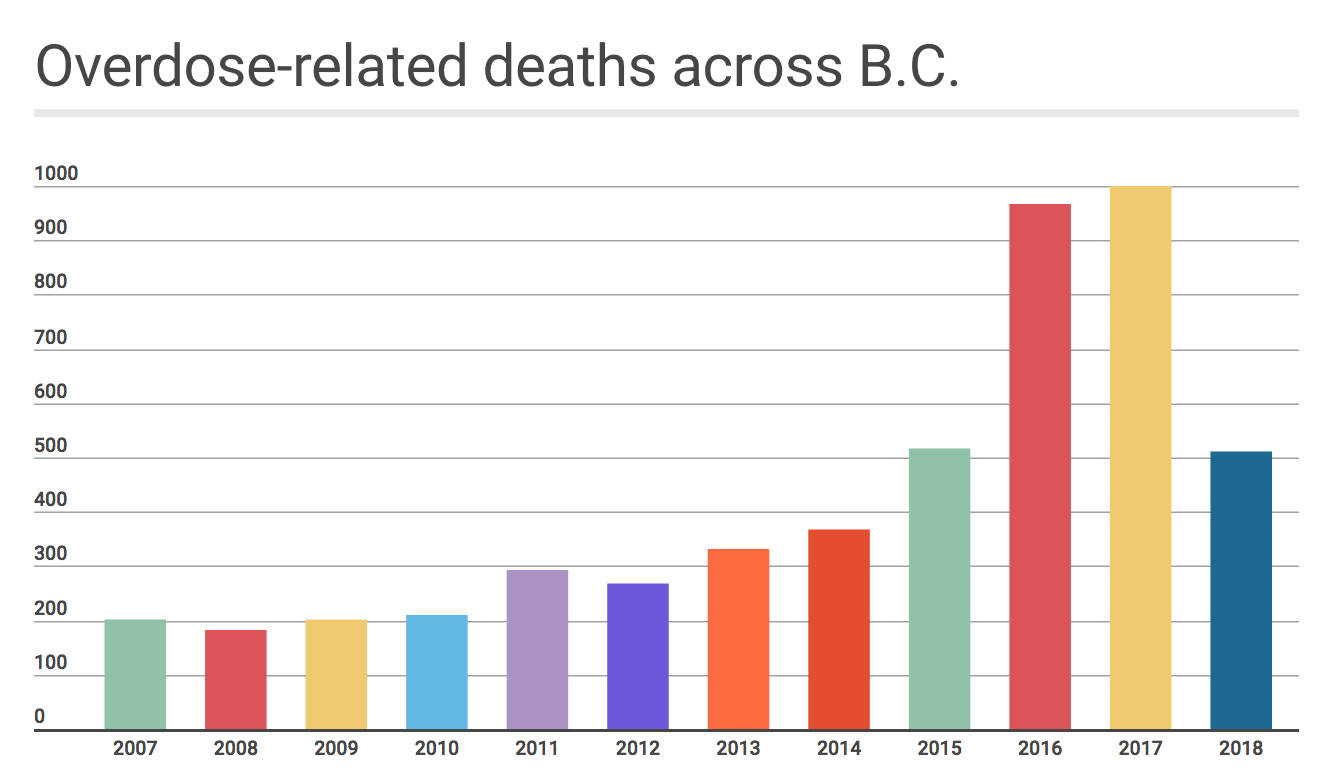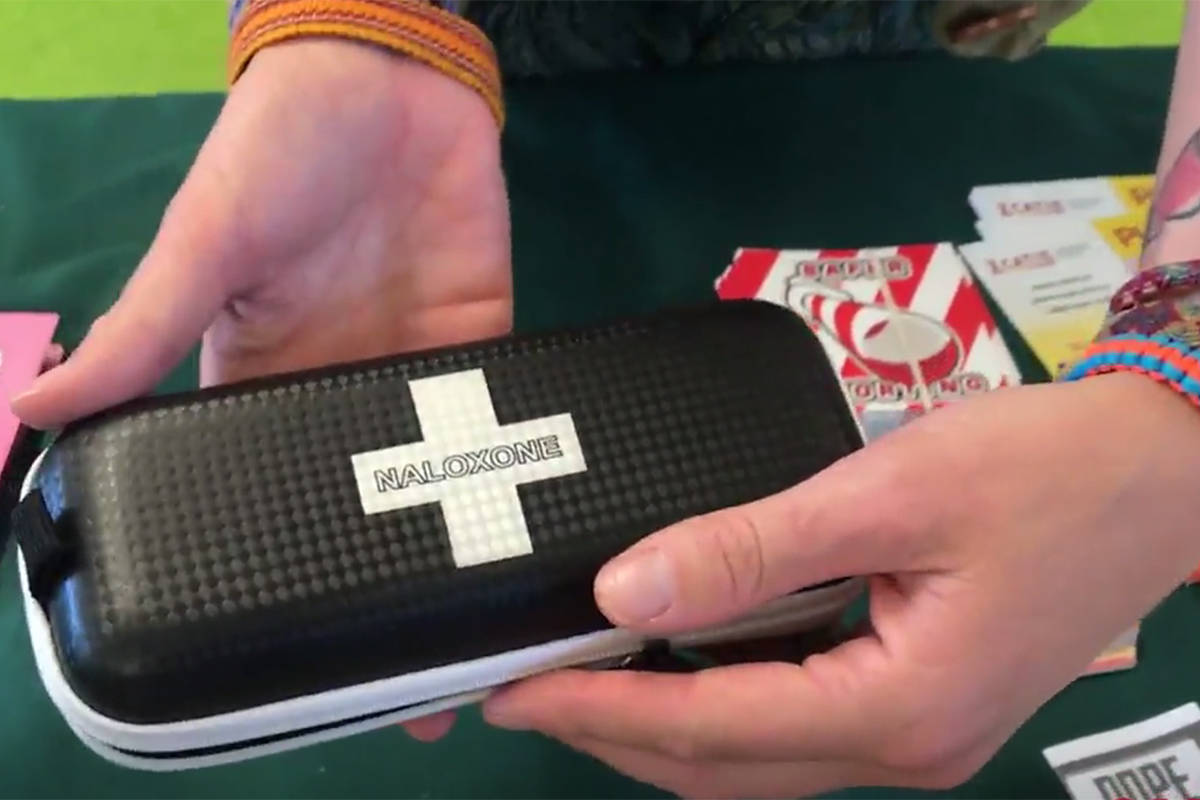In the wake of tragedy, Oak Bay students, parents and community members look for ways to address a growing problem that continues to wreak havoc on B.C. families – the latest announced last week with the suspected overdose death of a Grade 10 student at Belmont.
There have already been 511 fatal overdoses in B.C. so far this year, according to the latest numbers released by the provincial coroners service. 124 people in the month of April means that four people per day lost their lives to overdoses.
Communities are struggling with the reality that illicit fentanyl, often masked by other street drugs, is not a discerning killer. Regardless of age or whether it’s a first time drug user – the data shows it will kill you.
| Overdose-related deaths in B.C. from 2007-2018 |
After the death of Oak Bay High student Elliott Eurchuk in April, students and parents have been searching for ways to protect youth from the spreading issue of opioids and accidental overdoses.
The common chorus rising from the students, parents, and professionals addressing the issue is that communication, education, and connection are integral to battling the crisis.
The Oak Bay PAC Health and Wellness Committee began in Dec. 2017 in response to reports from parents and administration concerning Grade 9 and 10 students overdosing on Xanax.
“The parents would be called to pick their child up from the hospital and they would hear from the emergency doctors things like ‘this is the tenth kid this week’,” said Gabriela Hirt, co-chair of the Health and Wellness Committee. “But it was really anecdotal. There were no statistics.”
So the committee was formed and research on best-policies was undertaken. The parents are now calling on the school district and the B.C Government to make changes to drug-related policies and support in schools.
“We believe it to be self-evident that abstinence-oriented education and approaches regarding substance use are unlikely to be effective in preventing harm to our students, and that harm reduction education is necessary to ensure the health and safety of our students,” wrote Kami Bourgeois, OBHS PAC chair, in a May 16 letter to the superintendent of the Victoria School District.
The committee is urging the district to increase counselling resources and to “support the schools in implementing immediate pro-active preventative measures to keep youth healthy and safe.”
“Personally, I am feeling impatient that we still don’t have a harm reduction strategy for all schools in place by our district. Teaching kids how to stay safe and being able help their friends when they are in trouble seems to me of utmost urgency given the opioid crisis we are facing,” said Hirt. The district is working on one she says, but it has not yet been implemented.
The committee is asking for schools to have naloxone training for students and parents.
While naloxone training is not given at Oak Bay High, principal Randi Falls encourages students to seek out the resources in the community.
“If you want to get the training, go to the source. I really encourage the kids to go to the Foundry or to Aids Vancouver Island to see the amazing community supports that are readily available for the kids,” said Falls. “That they can be another conduit and another level of support.”
A few Oak Bay High students have sought to bring the resources to the students. They created a group called Connect to Care, a student-led initiative to remove stigma around substance use and to provide harm reduction aids and resources to youth. In May, they hosted a Connect to Care Health Fair at school, bringing together mental health and harm reduction resources from the community.
“One of our goals is to open conversations and remove the stigma around substance use because I know the topic has kind of been hidden away and I think it is important to address it and take action,” said student and organizer Jasmine Lee.
In attendance were Foundry Victoria, AIDS Vancouver Island, NEED2, and Recreation Oak Bay.
“We just want to protect each other and try to get past this. We just want to try to open the conversation so that when it is happening, asking for help isn’t something that is scary,” said fellow student and organizer Maddy Trimmer.
Foundry Victoria is part of a collective of youth clinics around B.C. that offer free, drop-in primary care, mental health, and sexual health care to youth between the ages of 12 and 24. Youth can drop in for same-day counselling, peer support, connection to community resources, physical resources, social work, outreach work – anything that can help a youth navigate a health care journey. The services are confidential and are open to all youth, including people who are street-involved or involved in substance use.
“No barrier supports – that’s what I want our kids to know about,” said Falls.
The clinic, at 818 Douglas Street, opened its doors this year.
“We know we need to build a seamless system of supports … where you ask once and you get help fast,” said Minister of Mental Health and Addictions Judy Darcy at the May ribbon-cutting ceremony of Foundry Victoria. “[Foundry] overcomes those silos, and brings the care together.”
Roughly 70 per cent of mental health issues emerge before the age of 25, Darcy said. In B.C., there are an estimated 84,000 people between the ages of four and 17 living with these challenges, yet only one in three will receive support.
RELATED: Centre for youth seeking mental health and addictions support opens in Victoria
AIDS Vancouver Island was at the Connect to Care health fair providing harm reduction information , sexual health supplies, and safer substance us information. They also had a sign-up sheet for students interested in doing naloxone training off-site. They offer training to anyone in the community that is interested and give a naloxone kit to everyone who completes the training. The training is also available online at www.towardtheheart.com.
“A mask comes in the kit. It is really important to know that naloxone is the second thing that you need. Oxygen is the most important thing that someone needs to respond to an overdose. That’s one breath every five seconds,” said Health Promotion Educator Lana Fine.
NEEDS2 was at the health fair to provide resources on suicide prevention, intervention and general mental wellness through their program Youth Space. It is an online text and chat support service for youth under 30 and serves about 5,000 youth a year. The conversations are confidential, one-on-one text and chat conversations that act as an intervention based service.
Kamma Wiggins, a fitness programmer for Recreation Oak Bay was also present to talk about youth programming.
“Most of our adult programs do start at 13 years of age for participating, so we want Oak Bay students to know that there are a lot of drop-in programs available to them,” said Wiggins.
As Liaison to Schools for Oak Bay Council, Coun. Michelle Kirby is organizing an event to carry on the conversation.
A community conversation on youth mental health and substance use is being held at the Dave Dunnet Community Theatre at Oak Bay High on June 19 from 7-9 p.m.. Youth and parents are invited to come and learn about what resources are available, how to talk about substance use with family members, and ways to help reduce risks. The event is free and open to the public.
RELATED: Moms Stop The Harm respond to opioid crisis
Resources
Kids Help Phone offers 24/7 counselling online at kidshelpphone.ca or by phone 1-800-668-6868
Sign up for Naloxone training at Toward the Heart: www.towardtheheart.com
Foundry Victoria provides a range of prevention and early-intervention health and social services to support young people’s well-being. Services are free and confidential for youth 12-24. 818 Douglas Street or foundrybc.ca/victoria/
Kuu-us Crisis Line Society for Indigenous youth by phone 1-800-588-8717
Youth Space offers online emotional and crisis chat and text youthspace.ca or text 6 p.m. to midnight 778-783-0177
The 24-hour Vancouver Island Crisis Line is an Island Health contracted service offers text 250-800-3806, online chat vicrisis.ca and phone services 1-888-494-3888
AIDS Vancouver Island avi.org
Jack.org movement of young leaders transforming the way we think about mental health
iMinds - Tools for building drug and gambling literacy
Canadian Institute for Substance Use Research (CISUR) - www.uvic.ca/research/centres/cisur






